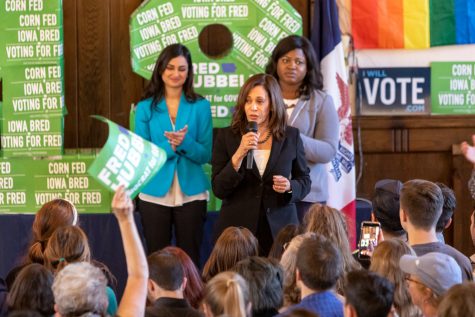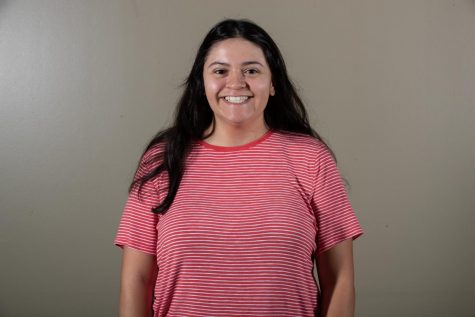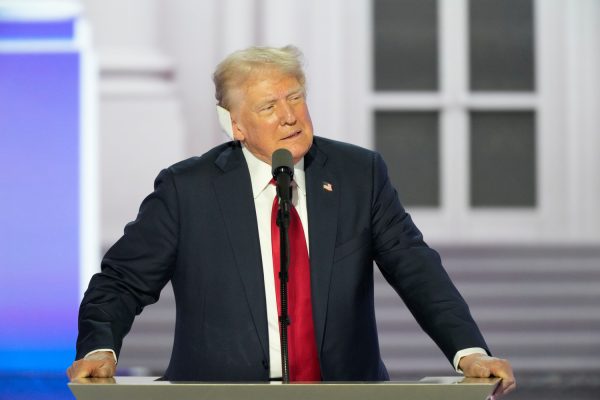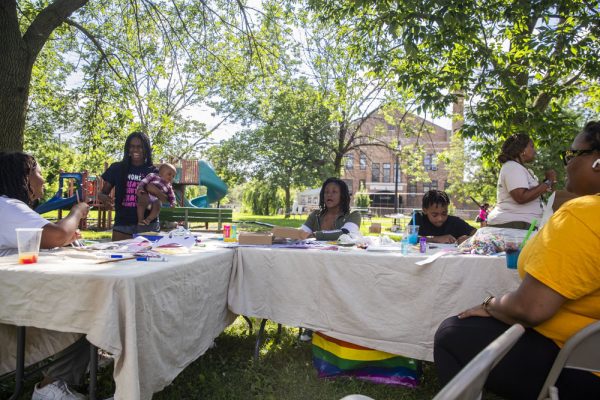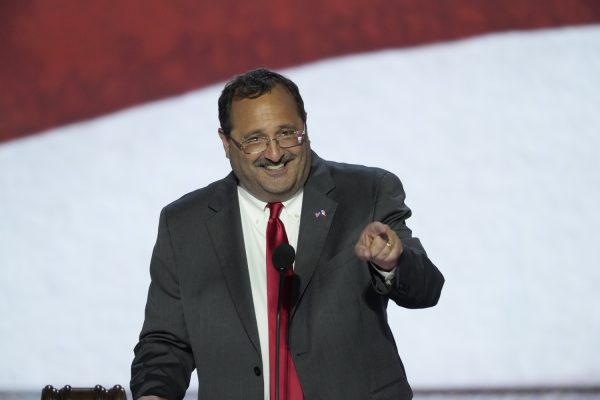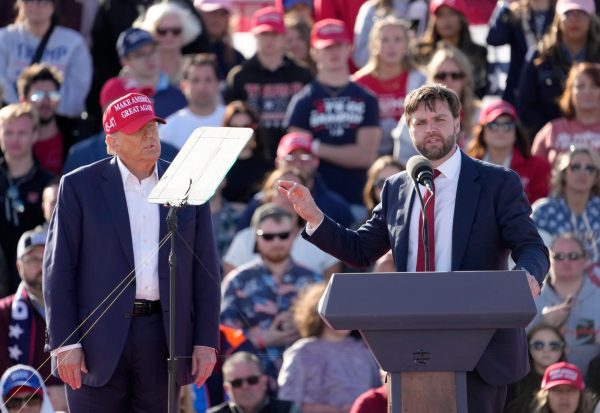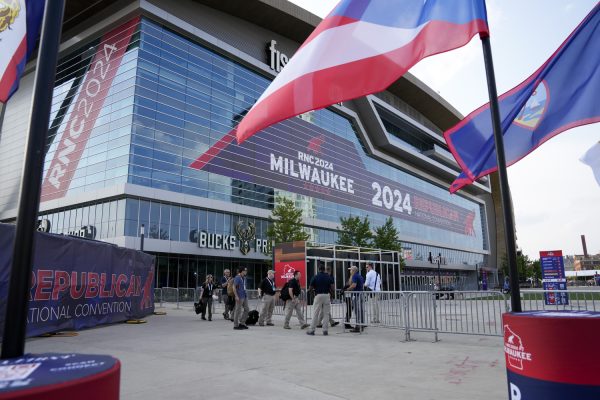In the heart of no-party country Blum and Finkenauer eye independent voters
In the too-close-to-call 1st District House race, independent voters hold the balance of power.
Both candidates stand ready during the Rob Blum and Abby Finkenaur debate at the University of Northern Iowa on Oct. 5, 2018. Blum and Finkenaur discussed many current issues including gun control and Brett Kavanaugh.
October 23, 2018
The sizable bloc of no-party voters in Iowa’s 1st Congressional District is casting uncertainty over the outcome of the race for the district’s seat in the U.S. House of Representatives between state Rep. Abby Finkenauer, D-Dubuque, and U.S. Rep. Rod Blum, R-Iowa.
The race has garnered national attention and attracted out-of-state dollars from nearly all 50 states, with Democrats eyeing the race as a pickup seat along the possible path toward regaining control of the House of Representatives in the midterm elections.
Political analysts and limited polling have rated Blum, running for a third term, as one of the most vulnerable Republican incumbents in the country. However, with no-party voters making up most of the district’s registered voters, voting patterns have been difficult to predict for the past few election cycles.
RELATED: Blum, Finkenauer face off at first debate in Cedar Falls
“The no-party part of this is really the big unknown that adds this enormous element of uncertainty to this race,” said Christopher Larimer, a political-science professor at the University of Northern Iowa.
Voters will soon determine who will represent them for the next two years, deciding between Finkenauer, the 29-year-old state legislator representing Dubuque hoping to put an end to what she calls “playing politics with policy,” and Blum, a 62-year-old incumbent who describes himself as an “independent voice for Iowans,” both trying to appeal to the no-party voters in the district.
I don’t feel excitement for either side. I don’t see people excited to vote for Rod Blum, I don’t see people really excited up here to vote for Abby Finkenauer.
— Laura Hubka, Democratic Party chair of Howard County
On the campaign trail, Finkenauer emphasizes working-class roots. She has said she will work to reduce unemployment, add a public option into the Affordable Care Act and improve education infrastructure if elected. Blum highlights his experience as a business owner, placing importance on limiting government spending and congressional reform in addition to revamping the public health-care system.
The District
Like other parts of the country, Iowa’s 1st District flipped from supporting Barack Obama in 2008 and 2012 to supporting candidate Donald Trump in 2016.
Howard County, located along the Iowa-Minnesota border, earned the title of the only county in the U.S. that voted for both Obama and Trump by more than 20 points, with a 41-point swing.
Howard County has the smallest population of the counties in the district. Estimates from the U.S. Census Bureau place the population of the county at approximately 9,000 residents as of July 2017.
Howard County Democratic Party Chair Laura Hubka said the county contained a tough political climate after 2016.
“We were able to see past that partisan politics side of our lives,” Hubka said. “[Now], I think everybody’s looking out of the side of their eye, and everybody’s trying to talk and make sure that nobody knows which side they’re on because that in itself, I think, can cause an issue.”
She said she senses a growing sense of apathy in the county.
“I don’t feel excitement for either side,” Hubka said. “I don’t see people excited to vote for Rod Blum, I don’t see people really excited up here to vote for Abby Finkenauer.”
Robin Stone, the Democratic Delaware County chair, said she had seen a similar outlook in her county following the previous election.
“Some apathy set in, and people were pretty darn discouraged after what happened in 2016,” she said.
However, she noted that the discouragement she saw has been turned into motivation heading into the midterm election.
“We’ve got some new energy … Our more long-term people are becoming more active again,” Stone said. “I think what has happened over the two years is some real motivation, because we recognize within our party that we can’t survive two more years of this, much less four.”
Iowa’s 1st District comprises 20 counties in the northeastern segment of the state. In 18 of those counties, people who identify as no-party make up the largest voting bloc.
In addition to a large bloc of no-party voters in the district, the number of registered Democrats leads Republicans. In an interview with The Daily Iowan, Blum said these conditions can make it hard for a Republican to be elected in the district. Before Blum, the seat had been held by a Democrat since 2007 — albeit in a somewhat different configuration before the redistricting after the 2010 Census.
The Candidates
I always tell people I didn’t know people in Hollywood really cared about Iowa, I didn’t know people in New York City really cared about Iowa.
— U.S. Rep. Rod Blum, R-Iowa
Eyes across the country have been watching Finkenauer and Blum throughout the campaign, bringing attention and dollars to both candidates’ campaigns.
Finkenauer often touts her background on the campaign trail, saying her upbringing as the daughter of a pipefitter helps her connect with working Iowans.
In debates, she’s criticized Blum for his vote for federal tax reform passed in 2017, saying the extra dollars are mostly going toward large corporations and the richest Americans.
Blum, a software company owner, argues the tax reductions have largely benefited the middle class. “I don’t know what country you’ve been living in for the last four, three, years, but our economy is absolutely booming if you haven’t noticed,” Blum said during an Oct. 15 debate. “And it’s due in large part to these tax cuts.”
Finkenauer was profiled in the New York Times series “Campaigning While Female,” which explored women running for offices across the U.S. breaking stereotypes and facing challenges associated with being a woman in politics.
She has also received endorsements from a variety of groups and politicians such as Emily’s List, Iowa Teamsters, and former President Barack Obama.
This attention has helped Finkenauer out-raise Blum approximately 3 to 1 on the campaign trail with a large portion coming from out-of-state sources.
California has been the top contributing state for Finkenauer’s campaign funding, according to data from the Federal Election Commission.
Blum has been critical of Finkenauer’s funding sources, noting he wishes money was not a large factor in elections.
“I always tell people I didn’t know people in Hollywood really cared about Iowa, I didn’t know people in New York City really cared about Iowa,” Blum said. “They don’t. That’s the bottom line — they just want to buy a congressional seat.”
As of June 30, Blum had raised approximately $74,000 from California, making it the No. 2 state in terms of campaign contributions. Finkenauer had raised approximately $445,000 from the state.
Blum, who has out-raised Finkenauer in Iowa, has also been the recipient of national attention and funding, having been backed by Americans for Prosperity, a group supported by the Koch Brothers, and a Republican political-action committee, the Congressional Leadership Fund, which began a $1 million ad buy in favor of Blum.
“All the money coming in shows how competitive the district is perceived by groups,” Larimer said. “That money is more focused on mobilizing voters who support each candidate.”
Previous elections
Blum won the seat in 2014 after narrowly beating Democratic challenger Pat Murphy by approximately 2 percentage points in an open-seat election. Democratic Rep. Bruce Braley had declined to run for re-election in order to run for Iowa’s open Senate seat, a race he lost to Joni Ernst.
Blum was re-elected in 2016, beating former Cedar Rapids City Councilor Monica Vernon by 7.5 percentage points in a race that was rated as a tossup by the Cook Political report in November 2016.
In previous elections, Blum said, he built momentum as Election Day neared, noting he generally started from behind. He believes this will be the case this year.
Polling shows Finkenauer narrowly leading with two weeks left until the election.
An internal poll for Blum, conducted Oct. 12-13 by the Polling Company, shows Finkenauer taking a lead by a 2 percentage points (within the margin of error). A previous poll conducted at the beginning of the month by the same company showed her leading by 1 percentage point.
Finkenauer said she is more focused on the personal feedback she receives on the campaign trail than polling results.
“I’m not taking anything for granted, and I’m working hard for the final weeks to get this across the finish line,” Finkenauer said in an email to The Daily Iowan.
Voter registration data for October show that of active registered voters in the 1st Congressional District, both Democrats and Republicans trail no-party voters, making winning independents a key for the district’s congressional campaigns.
Democratic county heads across the district have canvassed their communities through knocking on doors and using phone banks to increase support for Finkenauer.
Stone, the Delaware County Democratic head, said she uses research and lists from the Democratic Party to target independent voters, who make up 41 percent of active voters in the county, and Republicans who may vote for Democrats ahead of the election.
Stone said another part of gaining support for Democrats, including Finkenauer, is to target registered Democrats who typically sit out midterm elections.
The partisan makeup of Delaware County slightly departs from Iowa’s 1st Congressional District as a whole. As with many rural counties in the district, active registered Republicans outnumber Democrats.
“We used to be a blue county, and then just like a lot of places over the years, it’s gradually become a little more Republican,” Stone said.




